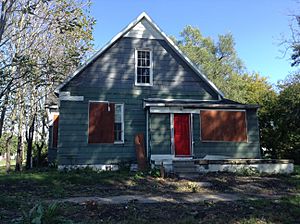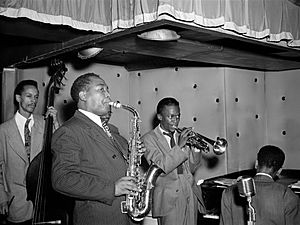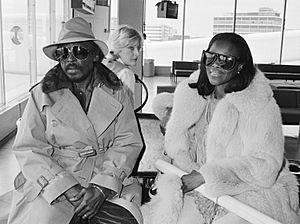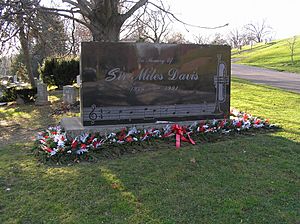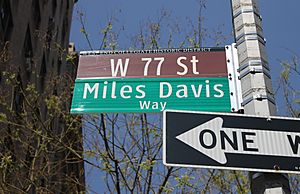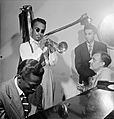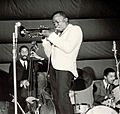Miles Davis facts for kids
Quick facts for kids
Miles Davis
|
|
|---|---|
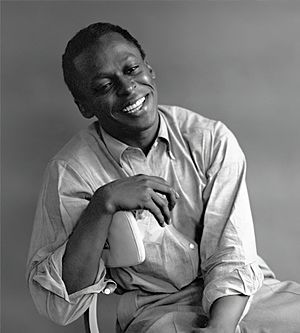
Davis in his New York City home, c. 1955–56; photograph by Tom Palumbo
|
|
| Background information | |
| Birth name | Miles Dewey Davis III |
| Born | May 26, 1926 Alton, Illinois, U.S. |
| Died | September 28, 1991 (aged 65) Santa Monica, California, U.S. |
| Genres | Jazz |
| Occupation(s) |
|
| Instruments | |
| Years active |
|
| Labels |
|
| Associated acts | Miles Davis Quintet |
| Education | Juilliard School |
| Spouse(s) |
|
Miles Dewey Davis III (born May 26, 1926 – died September 28, 1991) was a very famous American trumpeter, bandleader, and composer. He is known as one of the most important and respected people in the history of jazz music. Miles Davis explored many different musical styles during his career, which lasted for five decades. This kept him at the forefront of major changes in jazz music.
Contents
Early Life and Musical Beginnings
Miles Davis was born on May 26, 1926, in Alton, Illinois. His family was well-off. He had an older sister, Dorothy Mae, and a younger brother, Vernon. His mother, Cleota Mae Henry, was a music teacher and violinist. His father, Miles Dewey Davis Jr., was a dentist. They owned a large farm in Arkansas where Miles spent many summers.
In 1927, his family moved to East St. Louis, Illinois. They lived in a mostly white neighborhood. Miles's father worked very hard during the Great Depression. Miles went to John Robinson Elementary School and then Crispus Attucks. He was good at math, music, and sports. From a young age, he loved music, especially blues, big bands, and gospel.
In 1935, Miles received his first trumpet as a gift. He took lessons from Elwood Buchanan, a teacher and musician who greatly influenced him. Buchanan taught him to play without vibrato (a wavering sound) and to use a clear, mid-range tone. Miles said Buchanan would tap his knuckles if he used too much vibrato. The family later moved to 1701 Kansas Avenue in East St. Louis.
Miles said that by age 12, music was the most important thing in his life. For his thirteenth birthday, his father bought him a new trumpet. Miles began playing in local bands. He also took lessons from Joseph Gustat, the main trumpeter of the St. Louis Symphony Orchestra.
In 1941, at age 15, Miles attended East St. Louis Lincoln High School. He joined the marching band led by Buchanan. He also entered music competitions. Miles later shared that he faced unfair treatment in these competitions because of his race. However, he felt these experiences made him a better musician. He also started learning music theory to improve his playing.
Miles had a band that played at the Elks Club. He used some of his earnings to help pay for his sister's education. He became friends with trumpeter Clark Terry, who also told him to play without vibrato. Miles played with Terry for several years. He also became the musical director for the Rhumboogie Orchestra, which meant hiring musicians and planning rehearsals.
A Legendary Music Career
In September 1944, Miles Davis decided to study at the Juilliard School of Music in New York City. He passed the audition and took classes in music theory and piano. However, he left Juilliard after three semesters because he wanted to play music full-time. He later said the school focused too much on classical music. But he was thankful for learning music theory and improving his trumpet skills.
Miles Davis started his professional career playing with saxophonist Charlie Parker's bebop group from 1944 to 1948. Soon after, he recorded the Birth of the Cool sessions. These recordings were very important for the development of a new style called cool jazz. In the early 1950s, Davis recorded some of the first hard bop music.
After a successful performance at the Newport Jazz Festival, he signed a contract with Columbia Records. He recorded the album 'Round About Midnight in 1955. This was his first time working with saxophonist John Coltrane and bassist Paul Chambers. They became key members of his group in the late 1950s and early 1960s.
During this time, Miles Davis made orchestral jazz albums with arranger Gil Evans, like Sketches of Spain (1960). He also made famous band recordings such as Milestones (1958) and Kind of Blue (1959). Kind of Blue is one of the most popular jazz albums ever. It has sold over five million copies in the U.S.
Davis changed his band members often. He recorded Someday My Prince Will Come (1961) and Seven Steps to Heaven (1963). These albums introduced new talented musicians like bassist Ron Carter, pianist Herbie Hancock, and drummer Tony Williams. In 1964, saxophonist Wayne Shorter joined his new group. They created more experimental music, helping to start the post-bop style with albums like E.S.P (1965) and Miles Smiles (1967).
In the 1970s, Miles Davis started experimenting with rock, funk, and electronic music. This period, starting with In a Silent Way (1969) and ending with Agharta (1975), was very different from his earlier work. Some jazz fans found it surprising.
After taking a break for five years due to health issues, Miles Davis returned to music in the 1980s. He worked with younger musicians and added pop sounds to albums like The Man with the Horn (1981) and Tutu (1986). Even though critics sometimes had mixed feelings, this decade brought him his biggest commercial success. He performed sold-out concerts around the world. He also explored visual arts, film, and television.
In 1990, he received a Grammy Lifetime Achievement Award. In 1991, he acted in the film Dingo as a jazz musician. In 2006, Miles Davis was added to the Rock and Roll Hall of Fame. He is recognized as one of the most important musicians of the 20th century.
Personal Life
Miles Davis was married three times. His first marriage was to Frances Taylor, a dancer, from 1959 to 1968. He then married Betty Mabry, a model and songwriter, from 1968 to 1969. Betty introduced him to popular rock, soul, and funk music. His third marriage was to actress Cicely Tyson from 1981 to 1989. Cicely helped him find his passion for music again. In 1984, he met sculptor Jo Gelbard, who taught him how to paint. They often worked on art together.
Death and Lasting Impact
Miles Davis passed away on September 28, 1991, at the age of 65. His death was caused by a stroke, pneumonia, and breathing problems.
His funeral was held on October 5, 1991, in New York City. About 500 friends, family, and musicians attended. Many fans also stood outside in the rain. He was buried in Woodlawn Cemetery in New York City, near Duke Ellington's grave. One of his trumpets was buried with him.
Legacy and Influence
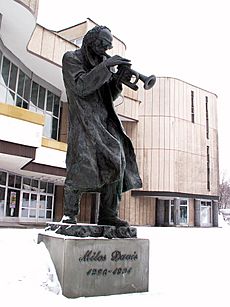
Miles Davis is seen as one of the most creative and respected people in music history. He is often called "one of the great innovators in jazz." He was also known as the "Prince of Darkness" and the "Picasso of Jazz." Many experts say that his career shows the history of jazz from the 1940s to the 1990s. He was part of almost every important new idea in jazz during that time.
His unique way of playing, which focused on personal expression and interacting with other musicians, had a huge impact on many jazz artists. In 2016, it was found that over 2,400 Wikipedia pages mention Davis, with more than 280 saying he was an influence.
In 2009, the U.S. House of Representatives honored his album Kind of Blue on its 50th anniversary. They also declared jazz a national treasure. The trumpet Miles Davis used on that album is now displayed at the University of North Carolina at Greensboro. The jazz program there is named the Miles Davis Jazz Studies Program.
Miles Davis received many awards during his life and after his death. In 1986, he got an honorary doctorate for his musical contributions. He won eight Grammy Awards and a Grammy Lifetime Achievement Award. In 2001, a documentary film about him, The Miles Davis Story, won an International Emmy Award. In 2012, the U.S. Postal Service released stamps honoring him.
A movie about his life, Miles Ahead, was released in 2015. That same year, a statue of him was put up in his hometown of Alton, Illinois. Listeners of BBC Radio and Jazz FM voted Miles Davis the greatest jazz musician.
Awards and Honors
Miles Davis won many awards for his music.
Grammy Awards
Miles Davis won eight Grammy Awards and was nominated thirty-two times.
| Year | Category | Work |
|---|---|---|
| 1960 | Best Jazz Composition of More Than Five Minutes Duration | Sketches of Spain |
| 1970 | Best Jazz Performance, Large Group or Soloist with Large Group | ... Brew |
| 1982 | Best Jazz Instrumental Performance, Soloist | We Want Miles |
| 1986 | Best Jazz Instrumental Performance, Soloist | Tutu |
| 1989 | Best Jazz Instrumental Performance, Soloist | Aura |
| 1989 | Best Jazz Instrumental Performance, Big Band | Aura |
| 1990 | Lifetime Achievement Award | |
| 1992 | Best R&B Instrumental Performance | Doo-Bop |
| 1993 | Best Large Jazz Ensemble Performance | Miles & Quincy Live at Montreux |
Other Awards and Recognitions
| Year | Award | Source |
|---|---|---|
| 1955 | Voted Best Trumpeter, DownBeat Readers' Poll | |
| 1957 | Voted Best Trumpeter, DownBeat Readers' Poll | |
| 1961 | Voted Best Trumpeter, DownBeat Readers' Poll | |
| 1984 | Sonning Award for Lifetime Achievement in Music | |
| 1986 | Doctor of Music, honoris causa, New England Conservatory | |
| 1988 | Knight Hospitaller by the Order of St. John | |
| 1989 | Governor's Award from the New York State Council on the Arts | |
| 1990 | St. Louis Walk of Fame | |
| 1991 | Australian Film Institute Award for Best Original Music Score for Dingo, shared with Michel Legrand | |
| 1991 | Knight of the Legion of Honor | |
| 1998 | Hollywood Walk of Fame | |
| 2006 | Rock and Roll Hall of Fame | |
| 2006 | Hollywood's Rockwalk | |
| 2008 | Quadruple platinum certification for Kind of Blue | |
| 2019 | Quintuple platinum certification for Kind of Blue |
Discography
This is a list of some of Miles Davis's most important studio albums. You can find a longer list in the main article.
- The New Sounds (1951)
- Young Man with a Horn (1952)
- Blue Period (1953)
- The Compositions of Al Cohn (1953)
- Miles Davis Volume 2 (1954)
- Miles Davis Volume 3 (1954)
- Miles Davis Quintet (1954)
- With Sonny Rollins (1954)
- Miles Davis Quartet (1954)
- All-Stars, Volume 1 (1955)
- All-Stars, Volume 2 (1955)
- All Star Sextet (1955)
- The Musings of Miles (1955)
- Blue Moods (1955)
- Dig (1956)
- Miles: The New Miles Davis Quintet (1956)
- Quintet/Sextet (1956)
- Collectors' Items (1956)
- Birth of the Cool (1957)
- 'Round About Midnight (1957)
- Walkin' (1957)
- Cookin' (1957)
- Miles Ahead (1957)
- Relaxin' (1958)
- Milestones (1958)
- Miles Davis and the Modern Jazz Giants (1959)
- Porgy and Bess (1959)
- Kind of Blue (1959)
- Workin' (1959)
- Sketches of Spain (1960)
- Steamin' (1961)
- Someday My Prince Will Come (1961)
- Seven Steps to Heaven (1963)
- Quiet Nights (1963)
- E.S.P. (1965)
- Miles Smiles (1967)
- Sorcerer (1967)
- Nefertiti (1968)
- Miles in the Sky (1968)
- Filles de Kilimanjaro (1968)
- In a Silent Way (1969)
- ... Brew (1970)
- Jack Johnson (1971)
- Live-Evil (1971)
- On the Corner (1972)
- Big Fun (1974)
- Get Up with It (1974)
- Agharta (1975)
- The Man with the Horn (1981)
- Star People (1983)
- Decoy (1984)
- You're Under Arrest (1985)
- Tutu (1986)
- Amandla (1989)
- Aura (1989)
- Doo-Bop (1992)
- Rubberband (2019)
Filmography
Miles Davis also worked on films, sometimes as a composer, performer, or actor.
| Year | Film | Credited as | Role | Notes | ||
|---|---|---|---|---|---|---|
| Composer | Performer | Actor | ||||
| 1958 | Elevator to the Gallows | Yes | Yes | — | The music for this film is known for its sad trumpet sound. | |
| 1968 | Symbiopsychotaxiplasm | Yes | Yes | — | Music by Davis, from his album In a Silent Way. | |
| 1970 | Jack Johnson | Yes | Yes | The music from this film became his 1971 album Jack Johnson. | ||
| 1972 | Imagine | Yes | Himself | A short appearance without being listed in the credits. | ||
| 1985 | Miami Vice | Yes | Ivory Jones | A TV series episode called "Junk Love." | ||
| 1986 | Crime Story | Yes | Jazz musician | A short appearance in a TV series episode called "The War." | ||
| 1987 | Siesta | Yes | Yes | — | Only one song was composed by Miles Davis with Marcus Miller. | |
| 1988 | Scrooged | Yes | Yes | Street musician | A short appearance. | |
| 1990 | The Hot Spot | Yes | Music composed by Jack Nitzsche, also featuring John Lee Hooker. | |||
| 1991 | Dingo | Yes | Yes | Yes | Billy Cross | The soundtrack was composed by Miles Davis with Michel Legrand. |
Images for kids
-
Miles Davis's septet in November 1971; left to right: Gary Bartz, Davis, Keith Jarrett, Michael Henderson, Leon "Ndugu" Chancler, James Mtume, and Don Alias
-
Miles Davis performing in Strasbourg, 1987
See also
 In Spanish: Miles Davis para niños
In Spanish: Miles Davis para niños


